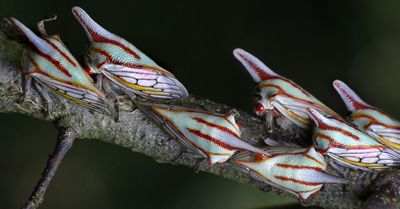
Oak Treehoppers (Platycotis vittatus)
It is no secret that insects are on the menu of a large number of other animals. Birds, lizards, frogs, fish, and even some mammals regularly eat bugs of all kinds. The insects, on the other hand, are not just passive protein packages waiting to be gobbled up by hungry vertebrates. A major driving force of evolution is the need for an individual to survive long enough to reproduce. An early demise, such as becoming a nestling's meal, spells a dead end for that critter's genes. Consequently, insects have evolved numerous defenses against the relentless hunting they endure.
One of the most fascinating solutions to evading predation is camouflage, or disappearing into the background. Since true invisibility for any biological being is only possible in fiction, the effect must be produced in more mundane ways. For small herbivorous animals, especially insects with their versatile exoskeletons, it is no stretch to see how they have come to complement their host plants in ways that make them seem to vanish as if by magic. One group of such insects includes planthoppers in the family membracidae.
Membracids, also called treehoppers, are so rarely noticed that most species lack common names. Exceptions are the rather showy Oak Treehoppers (Platycotis vittatus) and the Buffalo Treehoppers (Ceresa spp.). None are very large; they are usually 3 to 7 mm in length. They are also not all that numerous and/or they are just really difficult to find. Some are solitary and those that are gregarious often occur in small groups or in widely scattered places. Membracids are only one family of mostly small insects that feed on plant liquids. Related bugs include leafhoppers, spittlebugs, scale insects, aphids and the not-so-small cicadas. This group used to be classified in its own order: Homoptera. Current taxonomy merges the group with Hemiptera, the true bugs, examples of which are stink bugs, squash bugs, bed bugs, and water striders.
 Oak Treehoppers (Platycotis vittatus) |
All treehoppers have a tube-shaped proboscis through which they feed on plant liquids. As might be expected from the name, many species are found on the twigs of trees, but some prefer flowers or other herbaceous plants. I frequently find Vanduzea spp. clustered around the bases of flowers, especially sunflowers and daisies. They usually have ants attending to them, attracted to the honeydew, a sugary liquid that the bugs excrete as they feed. Another species, Entylia carinata, seemed to always be feeding at the center of oak leaves. It was several years before I figured out that those insects were females that were guarding eggs that had been deposited into the leaf veins.
The most interesting anatomical feature of these bugs is their pronotum, which is the section of the body right behind the head. This is the bit that forms the crest along their back, and it comes in a wide variety of shapes, colors and textures. Treehoppers tend to sit in one place most of the time. When they are disturbed, some will simply move a bit into a spot that enhances their similarity to the plant, often into the crook between a leaf petiole and the branch to which it is attached, which allows their coloration and shape to resemble a bud or leaf base. Other species will scoot around to the opposite side of the plant stem or branch, playing a hide-and-seek game that makes photographing them from the side nearly impossible. Still others will leap off their perch and fly off. As ungainly as those decorative body extensions may seem, they don't stop the insects from making a successful getaway.
As is often the case, the tropical fauna of any particular arthropod taxon is more elaborate, more varied and more speciose than their temperate zone counterparts. There are treehoppers found in equatorial areas that have all manner of spikes, horns, and branches sticking out of their bodies. By comparison, our local bugs are definitely less elaborate, but they still present a rather respectable assortment of oddball creatures that have evolved to great lengths to remain unnoticed. While matching the colors of bark, stems or leaves, they also mimic the shapes found around them, such as buds, thorns or leaf bits. Some have stripes that break up their outline, and many are so variable that a foraging warbler would have a hard time recognizing a nearby neighbor of its most recent snack as also being edible.
The first time I can remember learning about treehoppers was while looking through a very old National Geographic magazine. I used to get used copies at garage sales for 5 or 10 cents, and, though the oldest ones had more paintings and drawings than photos, I loved the pictures. There was a full page painting of a number of incredibly ornate treehoppers lined up on a vine tendril with a light blue background. I looked at that image many times because I'd just never seen any bugs that were so fantastic. When I found out that species here in the United States were not nearly so flamboyant, it was a bit of a disappointment.
Even though our fauna is subdued by comparison to that in a rainforest, it is still full of surprising and exquisite forms. Since these tiny insects are so difficult to find but look rather nifty, a small gallery of their portraits is warranted. Enjoy!
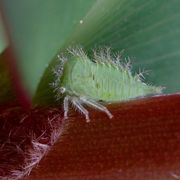 |  | 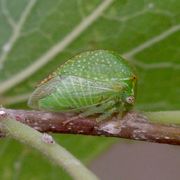 | 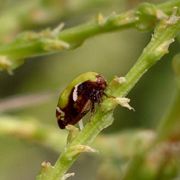 |
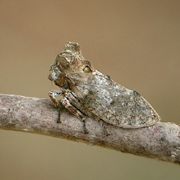 | 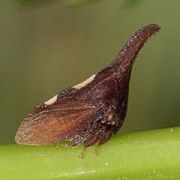 | 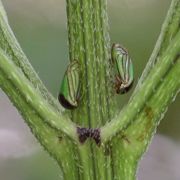 | 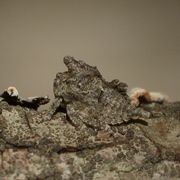 |
 |  |  | 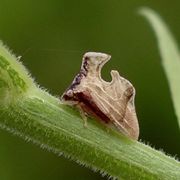 |
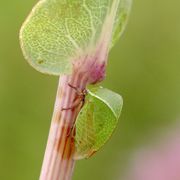 | 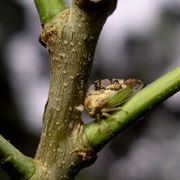 | 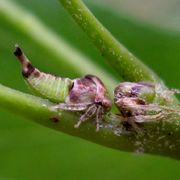 | 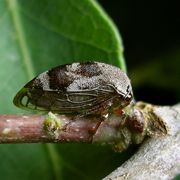 |